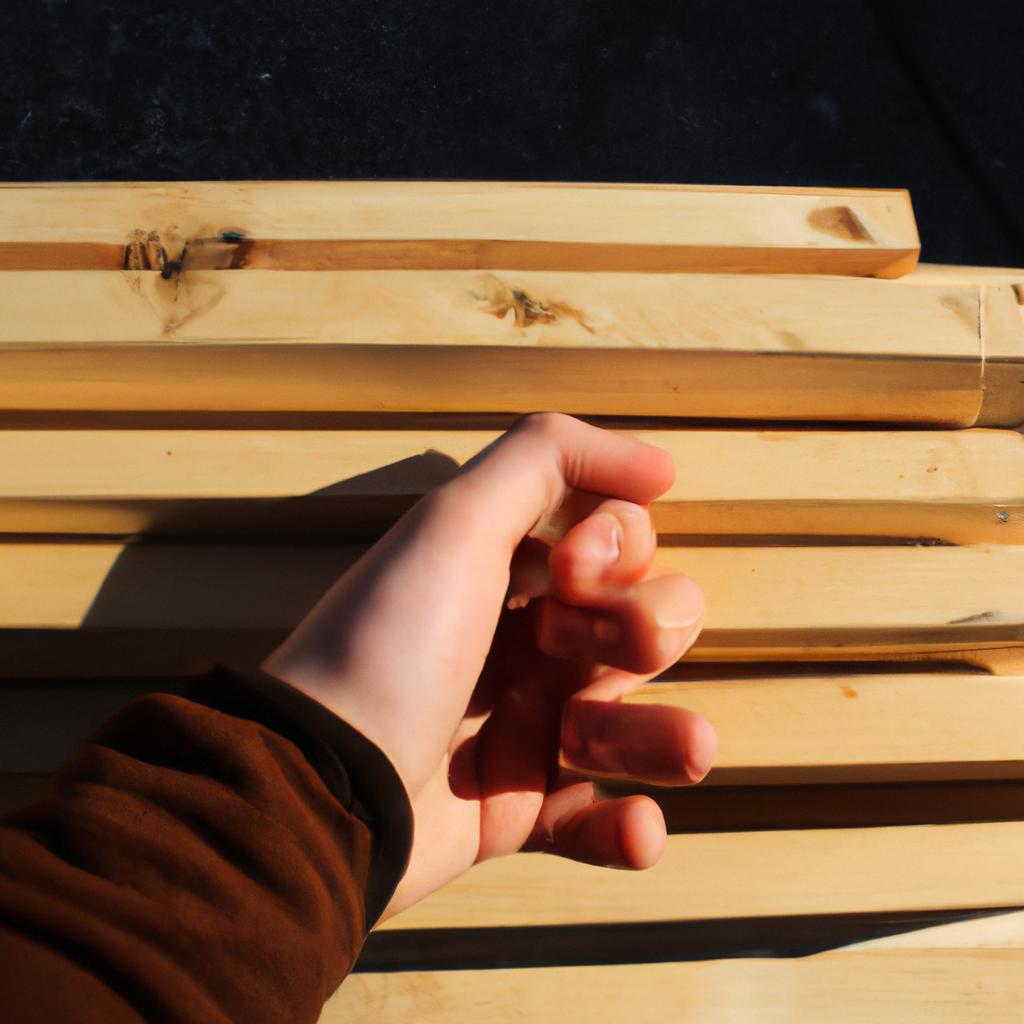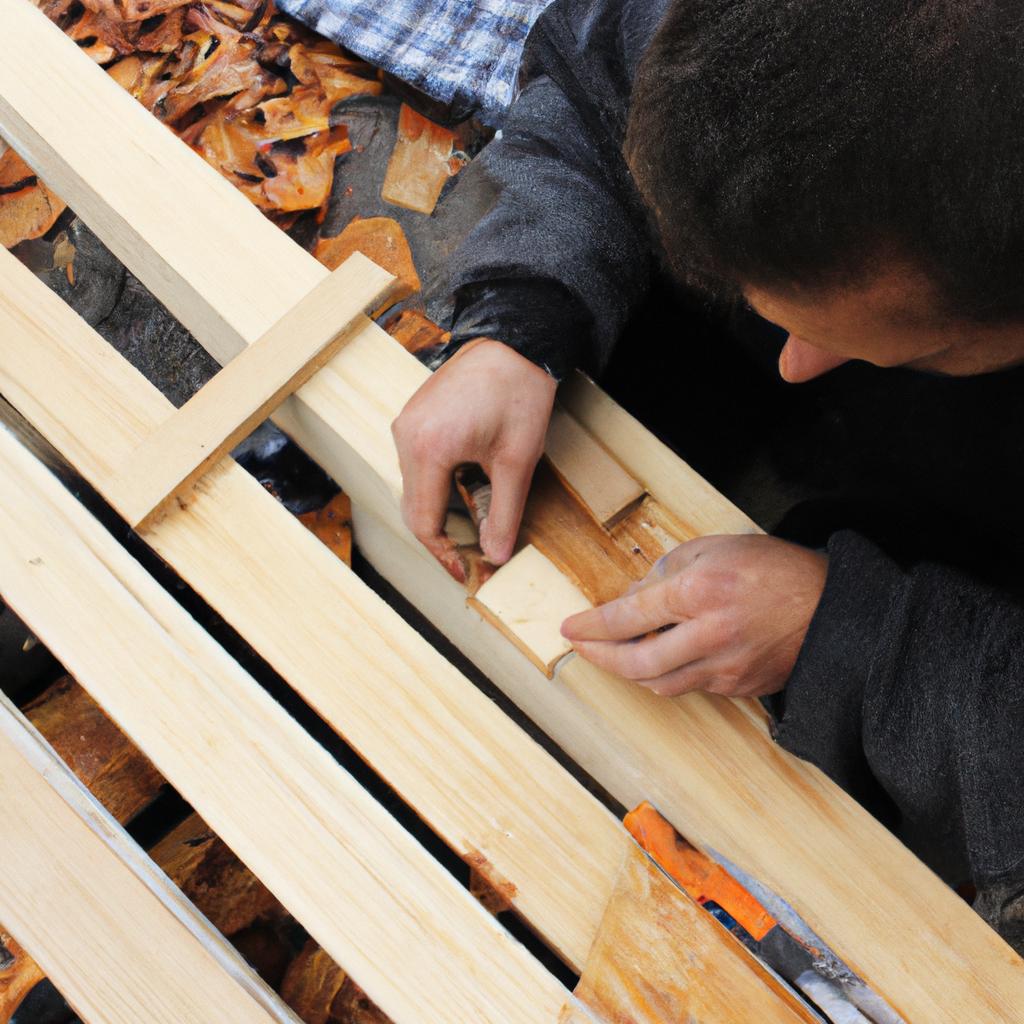Wood studs are a fundamental component of construction, serving as essential support structures in the framing of buildings. With their versatility and durability, wood studs have been widely utilized in various architectural designs and building projects. This informative guide aims to provide a comprehensive overview of wood studs as vital lumber and building materials, offering insights into their characteristics, applications, and benefits.
For instance, consider a hypothetical scenario where an architect is planning the construction of a single-family home. In this case study, the architect must carefully select suitable materials for the project’s framing structure. Wood studs emerge as a prime choice due to their inherent strength properties combined with cost-effectiveness. By understanding the different types of wood studs available and their respective advantages, builders can make informed decisions that ensure structural stability while adhering to budgetary constraints.
By delving into topics such as the composition and dimensions of wood studs, this article will explore how these building components contribute to overall structural integrity. Furthermore, it will discuss key considerations when selecting appropriate wood stud grades and treatments for specific construction scenarios. Additionally, this guide will emphasize sustainable practices by examining eco-friendly alternatives to traditional wood studs without compromising on performance or quality. Whether you are an aspiring builder or simply curious about the world of lumber and building materials, this comprehensive guide on wood studs will provide you with valuable insights and knowledge to navigate the world of construction effectively.
Types of Wood Studs
Wood studs are an essential component in the construction industry, serving as the primary structural support for walls, ceilings, and floors. Understanding the different Types of Wood Studs available is crucial for architects, builders, and homeowners alike. By selecting the appropriate type of wood stud for a specific project, one can ensure optimal structural integrity and performance.
To illustrate this point, let’s consider a hypothetical scenario where a builder is constructing a residential home. The builder must choose between two commonly used types of wood studs: dimensional lumber and engineered wood studs. Dimensional lumber refers to solid pieces of timber cut from trees, while engineered wood studs are manufactured using composite materials such as plywood or oriented strand board (OSB).
When comparing these two options, there are several factors to consider:
- Strength: Engineered wood studs often exhibit higher strength properties than dimensional lumber due to their composition and manufacturing process.
- Stability: Dimensional lumber may be susceptible to warping or twisting over time due to changes in moisture content. In contrast, engineered wood studs offer increased stability and resistance against deformation.
- Cost-effectiveness: Depending on local availability and market conditions, dimensional lumber may be more cost-effective compared to engineered wood studs.
- Sustainability: Engineered wood studs utilize smaller-diameter trees and waste products from other industries, making them a more sustainable choice overall.
It is important to note that the choice between dimensional lumber and engineered wood studs should be based on careful consideration of the specific requirements of each project. Factors such as load-bearing capacity, building codes/regulations, budget constraints, and environmental considerations all play significant roles in determining which type of stud would be most suitable.
Moving forward into our next section about Standard Dimensions of Wood Studs allows us to delve deeper into understanding how these different types translate into actual measurements for construction purposes.
Standard Dimensions of Wood Studs
Building on our understanding of the different types of wood studs, let us now delve into their standard dimensions. By examining these industry-standard measurements, we can gain a comprehensive understanding of how wood studs contribute to the structural integrity and stability of construction projects.
To illustrate the significance of standardized dimensions in practical terms, consider a hypothetical scenario where a contractor is tasked with erecting a residential structure. The architect’s design specifies that 2×4 wood studs be used throughout the project. With this information in hand, the contractor knows precisely what size lumber to procure for framing walls and supporting loads effectively.
In order to meet building code requirements and ensure consistency across projects, industry guidelines dictate specific dimensions for wood studs. These standards are designed to optimize strength while facilitating ease of installation. Key considerations include height, width, and length restrictions which guarantee uniformity within the field.
When it comes to standard dimensions for wood studs, here are some important points to note:
- Typical stud lengths range from 8 feet to 12 feet, although custom lengths can be ordered if required.
- Common widths include 2×4 (1.5 inches by 3.5 inches) and 2×6 (1.5 inches by 5.5 inches), but other sizes may also be available depending on regional variations or specific project needs.
- Height restrictions often align with local building codes and typically fall between 92⅝ inches (7 feet 8⅝ inches) and 104⅝ inches (8 feet 8⅝ inches).
- Some areas have adopted engineered wood products as an alternative to traditional dimensional lumber due to factors such as increased strength or environmental sustainability.
Emphasizing the importance of adhering to standard dimensions not only ensures compliance with regulations but also enables efficient planning during all stages of construction. This attention to detail ultimately contributes to a smoother workflow and reduces potential complications arising from inconsistencies or deviations.
Understanding the standard dimensions of wood studs allows us to appreciate their benefits in construction. Let us now explore how these versatile building materials enhance structural stability and offer versatility for various applications.
Benefits of Wood Studs in Construction
Wood studs are a popular choice in construction due to their versatility and numerous benefits. In this section, we will explore the advantages of using wood studs in building projects. To illustrate these benefits, let’s consider a hypothetical scenario where a contractor is constructing a residential home.
Firstly, one notable advantage of wood studs is their cost-effectiveness. Compared to other materials like steel or concrete, wood studs are generally more affordable. This makes them an attractive option for contractors working within budget constraints. Additionally, wood studs are widely available and easily sourced from local lumberyards, reducing transportation costs and lead times.
In terms of performance, wood studs offer excellent structural support. They have high strength-to-weight ratio properties that enable them to bear heavy loads while maintaining stability. Wood also has natural insulation properties, providing thermal resistance that helps regulate indoor temperature and reduce energy consumption.
To further appreciate the benefits of wood studs, here are some key points:
- Sustainability: Wood is a renewable resource when responsibly harvested.
- Ease of installation: Wood studs can be easily cut and shaped on-site to fit specific project requirements.
- Design flexibility: Wood allows for various architectural designs due to its workability and adaptability.
- Fire resistance: Treated wood studs can provide adequate fire protection measures when used in conjunction with proper fire-rated assemblies.
By considering these advantages, it becomes clear why many builders choose wood studs as a primary material in construction projects.
Common Uses for Wood Studs
Wood studs are a versatile and widely used building material in construction projects. In the previous section, we discussed the benefits of using wood studs. Now let’s delve into some common uses for this essential component.
Firstly, wood studs find extensive application in residential framing. For instance, consider a hypothetical case where a family decides to build their dream home. Wood studs would be employed to create the framework for walls, floors, and roofs. This sturdy foundation allows for easy installation of electrical wiring, plumbing systems, and insulation. Additionally, wood studs provide excellent soundproofing capabilities, ensuring privacy and comfort within the household.
In commercial construction projects such as office buildings or retail spaces, wood studs offer several advantages as well. Their cost-effectiveness makes them an attractive option for developers aiming to maximize their budget without compromising on quality. Moreover, wood studs can be easily customized to accommodate various architectural designs and layouts. Whether it’s creating partition walls or constructing interior structures like shelving units or display fixtures, wood studs allow for flexibility during the planning and execution stages.
Wood studs also play a crucial role in remodeling and renovation projects. Imagine a scenario where an old industrial warehouse is being transformed into trendy loft apartments. Wood studs can help divide large open spaces into individual living units while providing structural support for new additions like staircases or mezzanine levels. The versatility of wood studs ensures that they can adapt to changing design requirements throughout the renovation process.
To further emphasize the importance of wood studs in construction projects, here is a bullet point list highlighting their key attributes:
- Durability: Wood studs possess inherent strength and resistance against environmental factors.
- Sustainability: Timber used in wood stud production comes from renewable sources.
- Thermal Insulation: Wood has natural insulating properties that aid energy efficiency.
- Aesthetics: The warmth and beauty of wooden finishes enhance overall aesthetics.
Additionally, let us consider a table illustrating how different types of wood species commonly used for studs vary in terms of strength, moisture resistance, and availability:
| Wood Species | Strength (psi) | Moisture Resistance | Availability |
|---|---|---|---|
| Douglas Fir | 1,200 – 1,400 | Moderate | Abundant |
| Southern Pine | 1,000 – 1,250 | High | Widely |
| Hem-Fir | 800 – 900 | Low | Available |
| Spruce-Pine-Fir | 600 – 700 | Low | Common |
Choosing the most suitable wood species depends on factors such as regional availability and specific project requirements.
In conclusion to this section about common uses for wood studs, it is evident that they are an indispensable component in construction projects. The versatility of wood studs allows them to be utilized in various applications ranging from residential framing to commercial development and remodeling ventures. Next, we will explore important considerations when choosing wood studs for a project.
Choosing Wood Studs for a Project
Wood studs are a fundamental component in the construction industry, widely used for framing walls and providing structural support. In this section, we will explore the various factors to consider when choosing wood studs for your building project.
Before delving into the details, let’s consider an example that highlights the importance of selecting the right wood stud. Imagine you’re planning to build a new home in an area prone to earthquakes. Using low-quality or improperly sized wood studs could compromise the stability and safety of your structure during seismic events. Therefore, it is crucial to understand how different factors impact the selection process.
When Choosing Wood Studs for a project, several considerations come into play:
-
Size: The dimensions of the wood studs directly affect their load-bearing capacity and overall strength. Depending on your specific needs, you may opt for standard sizes such as 2×4 or 2×6 studs or choose more substantial options like engineered lumber products.
-
Wood Type: Different species of wood have varying properties that can influence their performance as studs. Common choices include pine, spruce, fir, and hemlock. Factors such as density, moisture resistance, and susceptibility to warping should be taken into account when determining which type of wood best suits your requirements.
-
Grade: Wood studs are graded based on their quality and appearance characteristics. Higher-grade materials typically exhibit fewer knots and imperfections but come at a higher cost. Understanding the grading system will help ensure you select suitable wood studs that meet both functional and aesthetic standards.
-
Sustainability: As environmental consciousness continues to grow within the construction industry, considering sustainability aspects becomes increasingly important. Look for certifications like Forest Stewardship Council (FSC) approval or inquire about eco-friendly alternatives such as recycled content or reclaimed wood.
To further illustrate these factors’ significance in decision-making processes, take a look at this table showcasing different types of wood commonly used as studs:
| Wood Species | Load-Bearing Capacity | Moisture Resistance | Cost |
|---|---|---|---|
| Pine | High | Low | Low |
| Spruce | Medium | Medium | Medium |
| Fir | High | High | High |
By considering these factors and evaluating their interplay, you can confidently choose the most appropriate wood studs for your specific project requirements.
Transitioning into the subsequent section about “Installing Wood Studs,” understanding how to select suitable wood studs is just the beginning. The next step involves properly installing them in a way that ensures structural integrity and longevity.
Installing Wood Studs
After carefully selecting the appropriate wood studs for your project, it is now time to move on to the installation process. To illustrate this, let’s consider a hypothetical scenario where we are building a partition wall in a residential home.
To begin with, there are several key steps involved in installing wood studs effectively:
-
Measuring and Marking: Before you start installing the wood studs, it is crucial to measure and mark the layout of your wall accurately. This will ensure that your studs are properly aligned and evenly spaced. Use a tape measure, level, and pencil to mark the locations of each stud along both the top and bottom plates.
-
Cutting and Positioning: Once marked, cut your wood studs according to the required length using a handsaw or power saw. Then, position them vertically between the top and bottom plates as per your earlier measurements. Ensure they fit snugly into place by tapping gently with a hammer if necessary.
-
Securing: After positioning the wood studs, secure them to both plates using nails or screws at regular intervals. These fasteners should penetrate through the stud and into the plate without splitting the wood. Utilizing construction adhesive can also enhance stability.
Now that we have discussed these essential steps for Installing Wood Studs, it may be helpful to visualize their significance in an engaging way:
-
Advantages of Proper Installation:
- Enhances structural integrity
- Provides support for various finishes such as drywall or paneling
- Improves sound insulation properties
- Increases fire resistance capabilities
Furthermore, here is a table summarizing different types of fasteners commonly used during stud installation:
| Fastener Type | Description | Usage |
|---|---|---|
| Nails | Commonly used due to cost-effectiveness | Suitable for most applications |
| Screws | Offers increased holding power | Ideal for heavy-duty or load-bearing walls |
| Bolts | Provides exceptional strength | Suitable for specialized applications |
| Staples | Quick and easy installation | Often used in temporary structures |
In conclusion, by following the steps outlined above and selecting the appropriate fasteners, you can confidently install wood studs to create a sturdy partition wall. Remember that precision and attention to detail are vital throughout this process, as it will ultimately contribute to the overall quality and durability of your construction project.
 Bergmann Lumber
Bergmann Lumber



